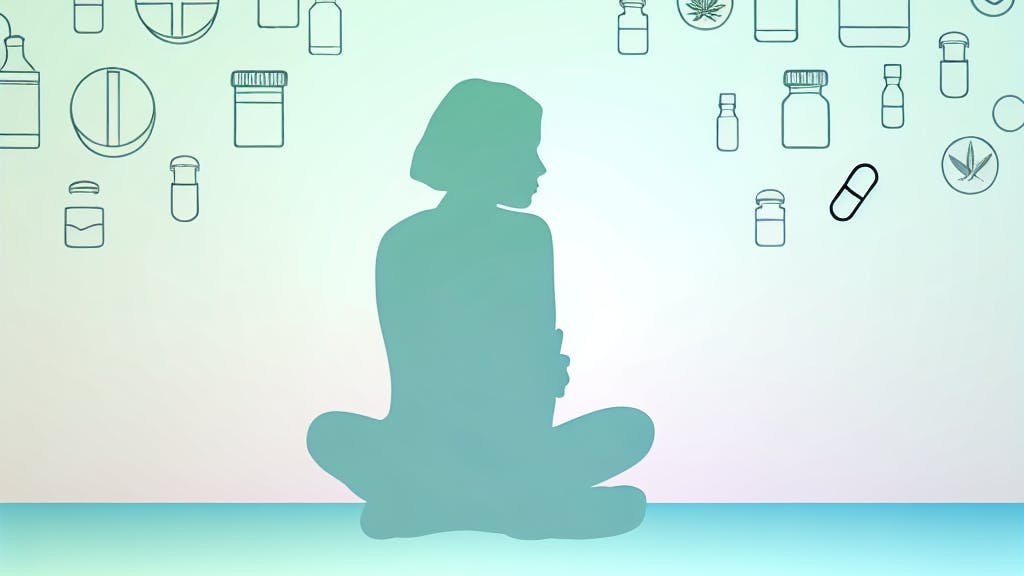Quality of life (QoL) scales help measure how mental illness affects daily life. Here are the top 5 QoL scales for mental health:
- WHOQOL-BREF Scale
- SF-36 Survey
- Q-LES-Q Assessment
- MANSA Evaluation
- AQoL-8D Measure
These scales assess various aspects of life quality, including:
- Physical health
- Mental state
- Social relationships
- Living conditions
- Daily functioning
Quick Comparison:
| Scale | Focus | Questions | Time to Complete | Best For |
|---|---|---|---|---|
| WHOQOL-BREF | General QoL | 26 | 10-15 min | Cross-cultural use |
| SF-36 | Physical & mental health | 36 | 5-10 min | Long-term conditions |
| Q-LES-Q | Mental illness | 93 (long), 18 (short) | 40-45 min (long), 10-12 min (short) | Treatment evaluation |
| MANSA | Severe mental illness | 16 | 15 min | Schizophrenia patients |
| AQoL-8D | Mental health impact | 35 | 5 min | Depression & anxiety |
These scales help doctors and researchers:
- Assess treatment effectiveness
- Track changes in QoL over time
- Identify areas needing support
- Facilitate patient-doctor communication
Related video from YouTube
1. WHOQOL-BREF Scale
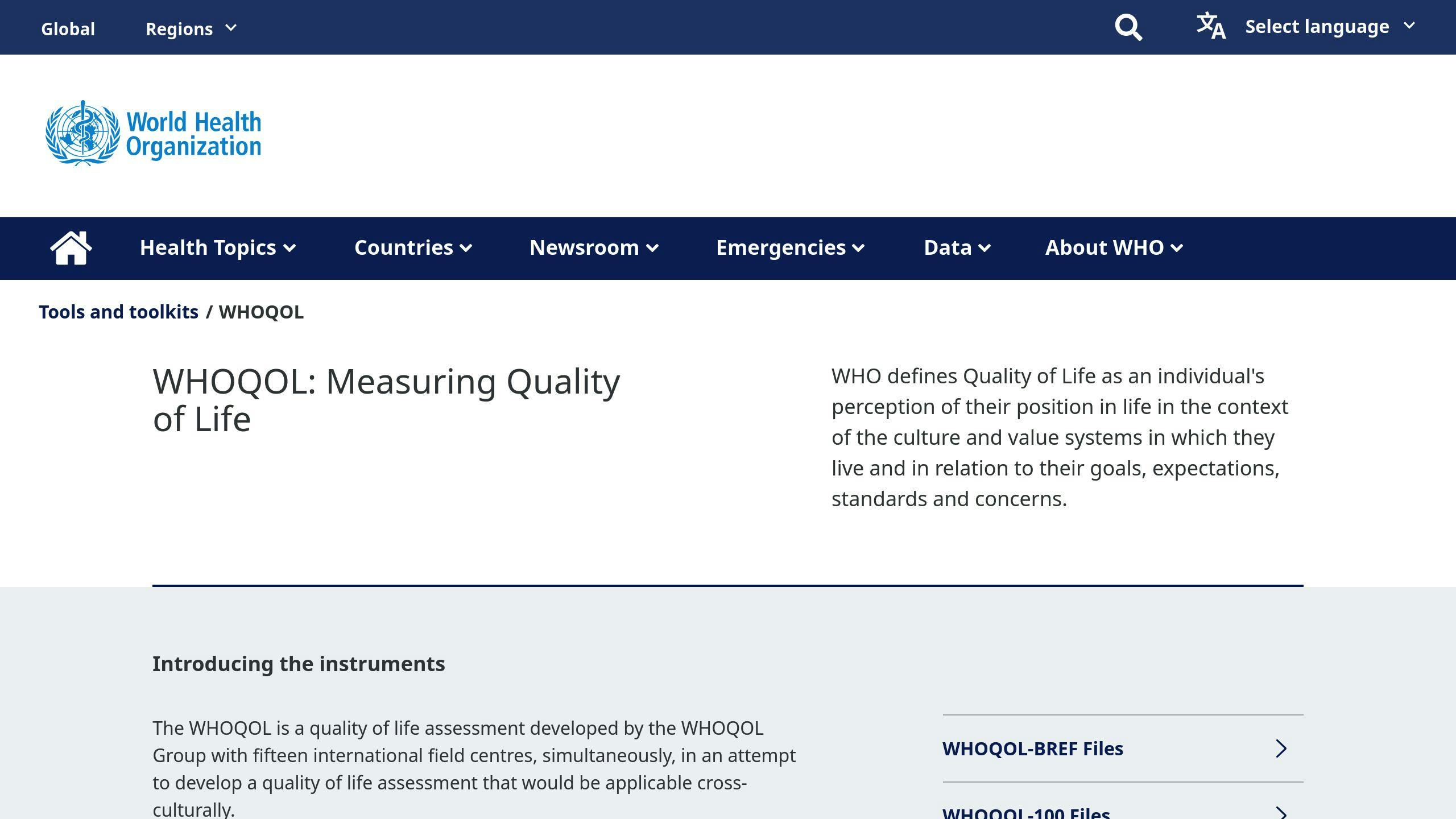

The World Health Organization Quality of Life-BREF (WHOQOL-BREF) scale helps measure how mental illness affects a person’s life. It’s a shorter version of a longer test and looks at how people see their life quality based on their culture and values.
Key Features
The WHOQOL-BREF looks at four main areas:
- Physical health
- Mental state
- Social life
- Living conditions
It also asks two extra questions about overall life quality and general health.
Pros and Uses
| Feature | Benefit |
|---|---|
| Short | Quick and easy to use |
| Many languages | Can be used in different countries |
| Covers many areas | Gives a full picture of life quality |
| Well-tested | Proven to work well in studies |
Doctors and researchers use this scale to understand how mental illness affects people’s lives.
Mental Health Considerations
While not made just for mental illness, the WHOQOL-BREF can still help understand how mental health problems affect life quality. But some questions might not fit all mental health situations.
How Well It Works
Studies show the WHOQOL-BREF:
- Gives consistent results
- Can tell different groups apart
- Asks the right questions
- Gives similar results when used again
These facts show it works well for different groups, including people with mental health issues.
2. SF-36 Survey
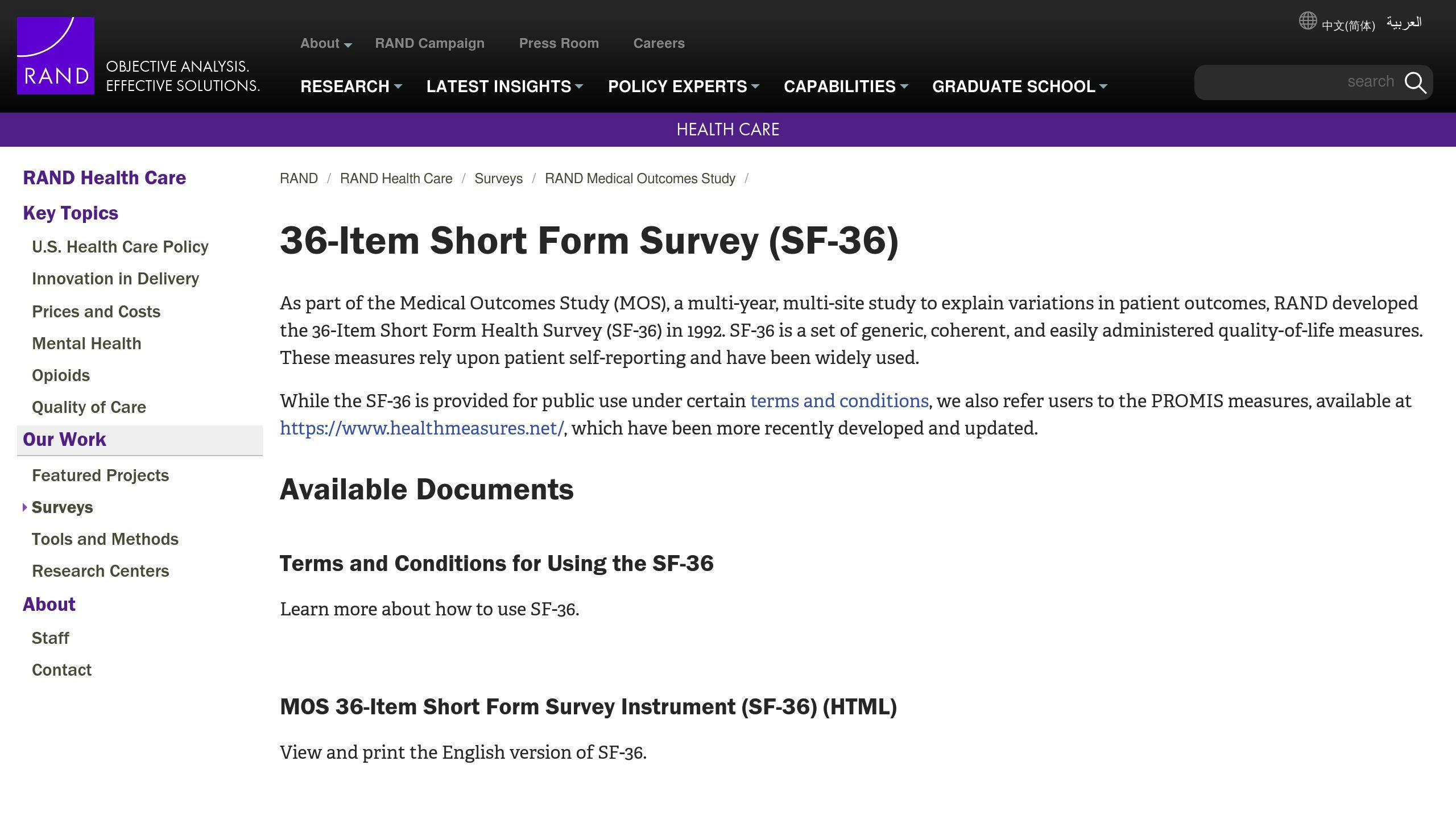

The SF-36 is a common tool used to measure quality of life, especially for people with long-term mental health issues. It’s a 36-question survey that takes about 5 minutes to finish.
What It Measures
The SF-36 looks at eight areas of health:
| Health Area | Description |
|---|---|
| Physical Functioning | How well you can do physical activities |
| Role-Physical | How physical health affects your work or daily tasks |
| Bodily Pain | How much pain you feel and how it affects your life |
| General Health | Your overall health |
| Vitality | How much energy you have |
| Social Functioning | How your health affects your social life |
| Role-Emotional | How emotional problems affect your work or daily tasks |
| Mental Health | Your overall mental well-being |
These eight areas give two main scores: one for physical health and one for mental health.
How Well It Works
The SF-36 has been tested a lot and:
- Gives the same results when used more than once
- Measures what it’s supposed to measure
- Can spot changes in health over time
Using It in Clinics
While the SF-36 works well for looking at groups, it might not be as good for checking one person at a time. This is because each part is short and doesn’t have many score levels.
Comparing to Others
One good thing about the SF-36 is that you can compare scores to what’s normal. For example, people with long-term back pain often score lower than the average person with back pain in the US.
Who Uses It
The SF-36 is used all over the world. Almost 100,000 people have permission to use it. It works for many health problems, including mental health issues, so both researchers and doctors find it helpful.
3. Q-LES-Q Assessment
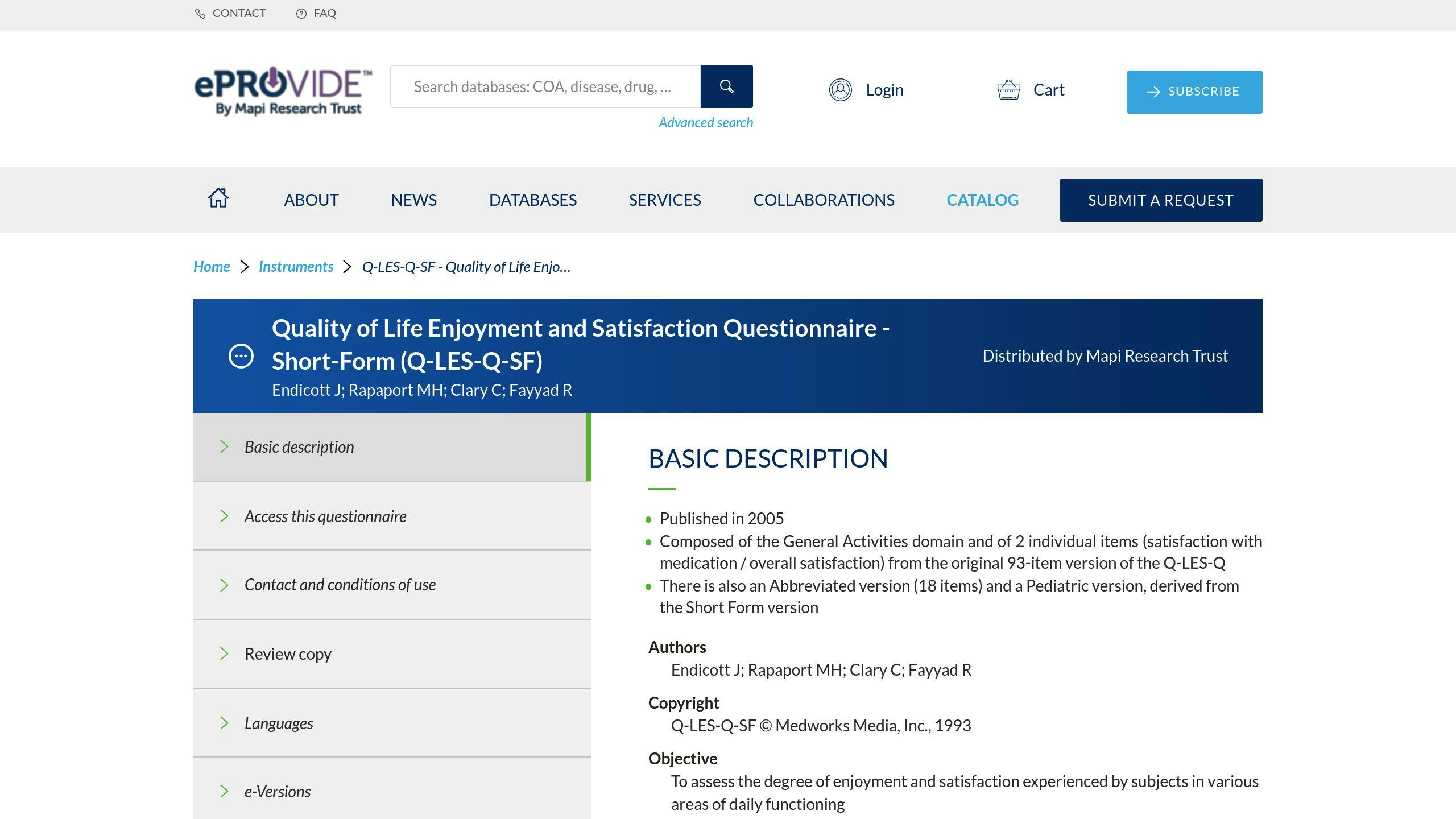

The Quality of Life Enjoyment and Satisfaction Questionnaire (Q-LES-Q) measures life quality for people with mental illness. It’s used in research and by doctors to understand how patients feel about their lives.
Key Features
| Feature | Description |
|---|---|
| Full Name | Quality of Life Enjoyment and Satisfaction Questionnaire |
| Versions | Long (93 questions), Short (18 questions) |
| Languages | English, French, Hebrew, Turkish |
| Time to Complete | Long: 40-45 minutes, Short: 10-12 minutes |
| Who Fills It Out | The patient |
What It Measures
The Q-LES-Q looks at these parts of life:
- Physical Health
- Feelings
- Free Time Activities
- Relationships
- Daily Tasks
- How Well Medicine Works
- Overall Life Satisfaction
This helps give a full picture of how someone is doing in different areas of their life.
How It’s Used
The Q-LES-Q helps:
- Check if treatments are working
- See how life quality changes over time
- Find areas where someone might need help
- Make it easier for patients to talk to their doctors about how they feel
Does It Work Well?
Studies show the Q-LES-Q is a good tool:
- It gives steady results when used more than once
- It measures what it’s supposed to measure
- Many researchers and doctors use it, which shows it’s trusted
A study in Argentina found that the questions work well together and measure different parts of life quality as they should.
sbb-itb-3d0b96e
4. MANSA Evaluation
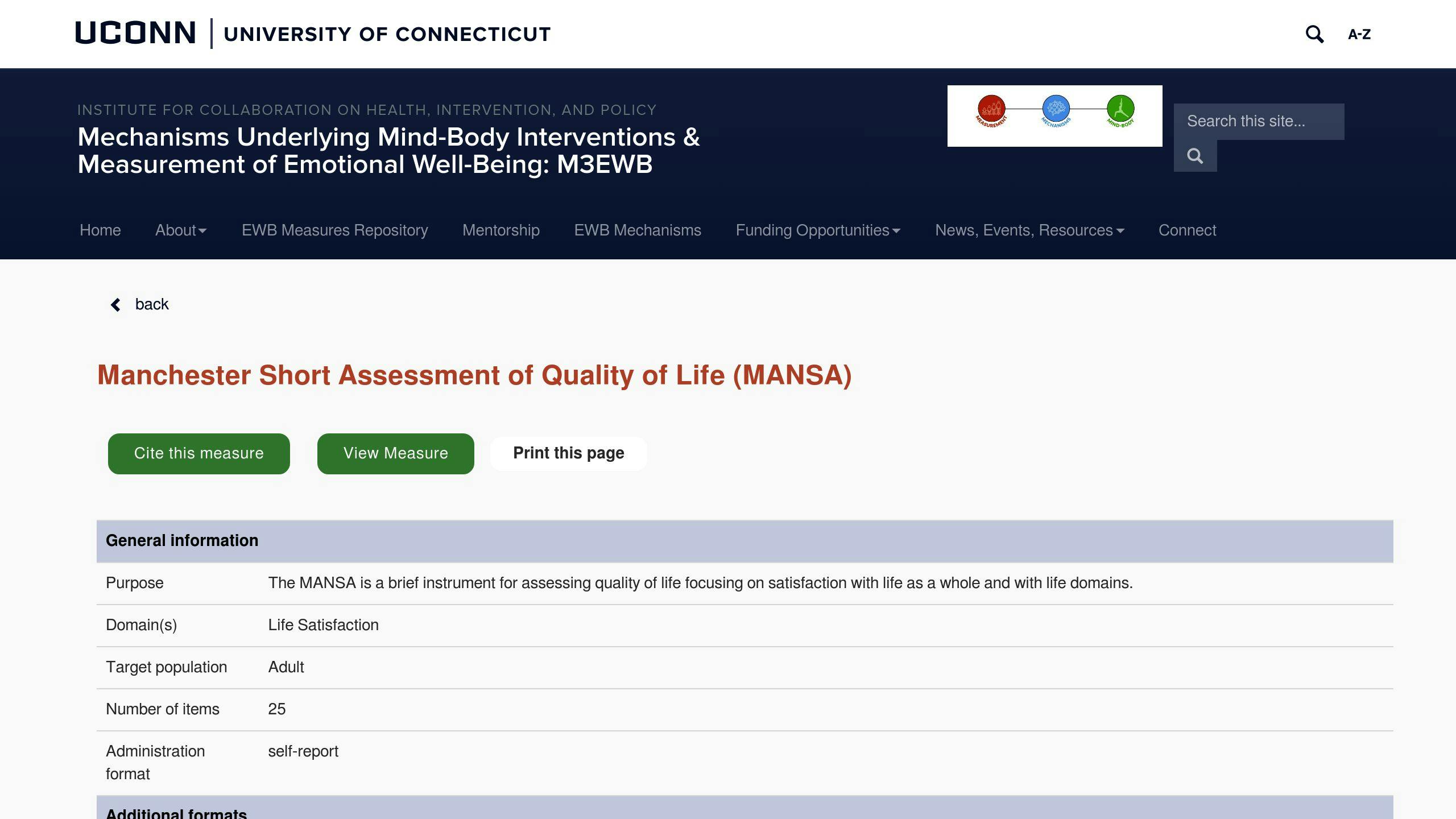

The Manchester Short Assessment of Quality of Life (MANSA) is a quick test that checks how happy people with serious mental health problems are with their lives. It’s often used for people with schizophrenia.
What MANSA Does
| Feature | Details |
|---|---|
| Full Name | Manchester Short Assessment of Quality of Life |
| Languages | English, German, Swedish |
| Who Uses It | Doctors or patients |
| Time Needed | About 15 minutes |
| Questions | 16 total (4 yes/no, 12 about feelings) |
| Cost | Free to use |
How It Works
MANSA has 16 questions:
- 4 simple yes/no questions about real-life facts
- 12 questions about how people feel about different parts of their life
This mix helps doctors understand both what’s happening in a person’s life and how they feel about it.
Is It Good?
Studies show MANSA works well:
- It gives steady results when used more than once
- It matches up with other ways of checking how people are doing
- It shows links between life quality and things like friends, feeling in control, and mental health symptoms
How People Use It
MANSA is helpful in many ways:
- Doctors can quickly see how happy a patient is with their life
- It shows where people might need extra help
- Researchers use it to study life quality for people with mental health problems
- It can track how someone’s life changes over time or after treatment
The test is short and covers many areas, making it useful for both doctors and researchers working with people who have serious mental health issues.
5. AQoL-8D Measure
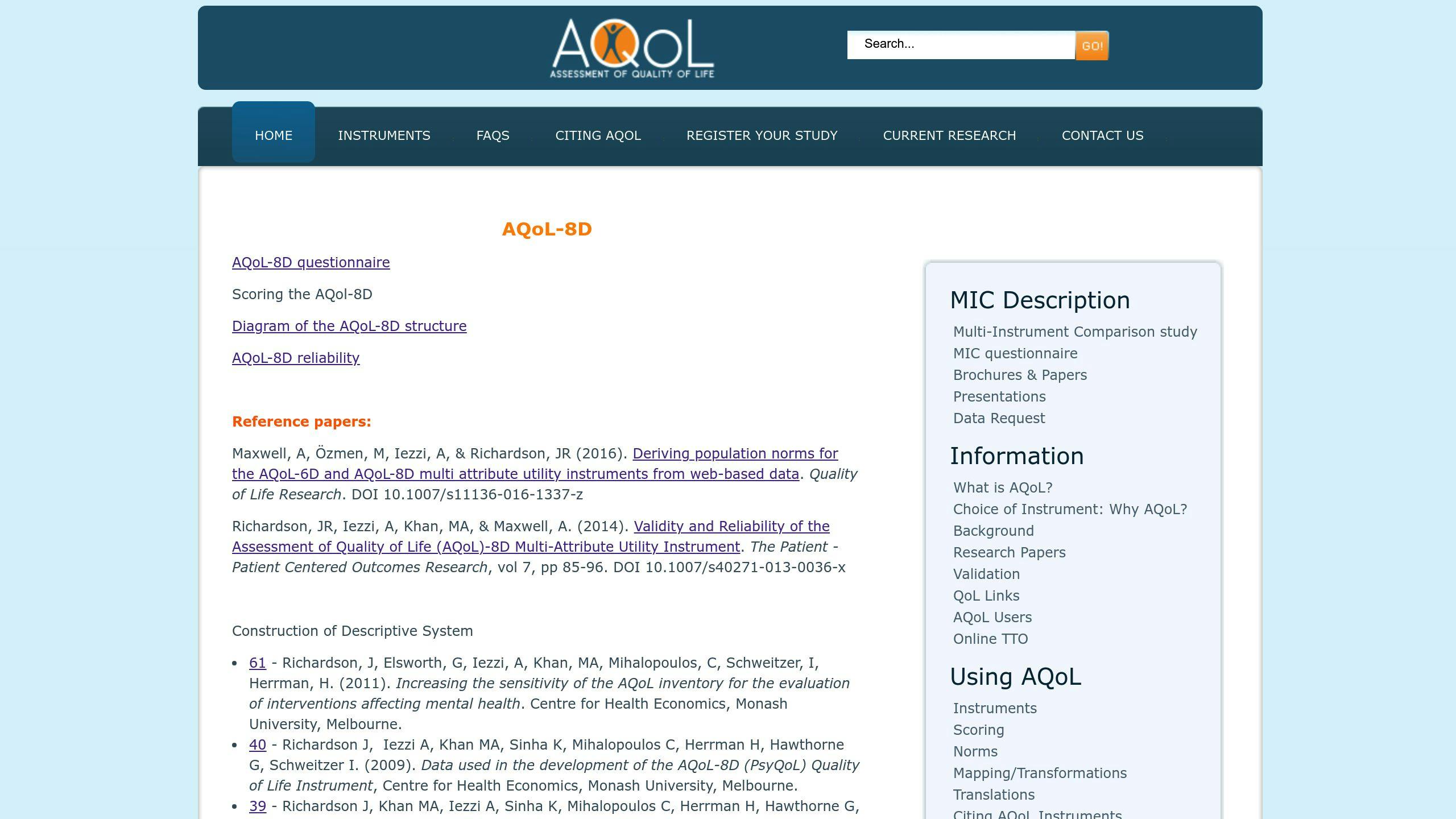

The AQoL-8D is a tool that checks how mental health affects life quality. It has 35 questions and looks at both physical and mental well-being.
Main Points of AQoL-8D
| Feature | Details |
|---|---|
| Areas Covered | 8 areas, 2 focus on mental health |
| Questions | 35 |
| Scores | 35-175 for overall score, 0-35 for health score |
| How to Take | Self-done, by mail or in person |
| Time Needed | About 5 minutes |
The AQoL-8D is good for checking life quality for people with mental health issues.
What It Looks At
The test has eight areas in two main groups:
-
Physical Group:
- Daily Living
- Senses
- Pain
-
Mental and Social Group:
- Mental Health
- Relationships
- Coping
- Self-Worth
- Happiness
This setup helps get a full picture of someone’s life quality.
How Well It Works
Studies show the AQoL-8D:
- Matches well with other similar tests
- Gives steady results for different groups
- Works very well for checking life quality in people with depression
Use in Mental Health
The AQoL-8D helps check life quality for people with:
- Depression
- Anxiety
- Schizophrenia
- Bipolar disorder
It’s good at spotting changes in life quality due to mental health.
Good and Bad Points
Good:
- Covers many mental and social areas
- Spots small changes in mental health-related life quality
- Tested in many countries and patient groups
Not So Good:
- Longer than some other tests
- Might take more time to do and score
The AQoL-8D is very helpful for people working in mental health. It gives a detailed look at how mental health affects life quality.
How the Scales Compare
When looking at quality of life scales for mental illness, it’s important to know how they stack up against each other. Each scale has good points and not-so-good points that make it better for certain uses.
Good and Bad Points of Each Scale
| Scale | Good Points | Not-So-Good Points |
|---|---|---|
| WHO-Five | – Short and easy to use – Looks at feeling good – Good for testing depression drugs |
– Only looks at feeling good – Might miss other parts of life quality |
| MOS SF-36 | – Used a lot and proven to work – Checks many parts of health and life |
– Takes longer to do – Not just for mental health |
| Q-LES-Q | – Made for people with mental health problems – Has a shorter version (Q-LES-Q-18) |
– Might not be tested as much as other scales |
| PGWB | – Focuses on mental well-being – Used a lot to check life quality |
– Might not cover all areas of mental illness |
| Quality of Life Scale (QOLS) | – Looks at 16 parts of life satisfaction – Includes being independent – Gives steady results |
– Might not be just for mental illness – Takes longer because it has 16 questions |
This table shows that each scale is good at different things. The WHO-Five is quick and good for checking if depression drugs work. The MOS SF-36 and PGWB are used a lot and check many parts of health and well-being.
For checking mental health specifically, the Q-LES-Q is good because it’s made for people with mental health problems. The QOLS looks at many parts of life, which can be good for people with long-term illnesses.
When picking a scale, doctors and researchers should think about what they need for their study or patients. They need to balance how much the scale covers, how good it is for mental illness, and how easy it is to use.
Wrap-up
Quality of life scales help measure how mental illness affects people’s lives. This article looked at five main scales. Each one has its own good points and uses.
Key Points About the Scales
| Scale | Main Focus | Best For |
|---|---|---|
| WHO-Five | Feeling good | Checking depression treatments |
| MOS SF-36 | Many health areas | Overall health check |
| Q-LES-Q | Mental health issues | People with mental illness |
| PGWB | Mental well-being | Checking life quality |
| QOLS | Life satisfaction | Long-term illnesses |
Choosing a Scale
When picking a scale, think about:
- How well it spots changes
- Who you’re checking
- What treatment you’re looking at
- How the questions are asked
A good scale should:
- Check all important parts of life quality
- Show changes from treatments
Using Scales in Practice
Quality of life scales help doctors and researchers:
- See how treatments work
- Understand patients better
- Find areas where people need help
FAQs
What is the quality of life mental health scale?
A quality of life mental health scale is a tool that checks how happy people are with their lives, focusing on mental health. One common scale is the WHOQOL-BREF, made by the World Health Organization.
The WHOQOL-BREF is a shorter version of a longer test. It looks at four main areas of life:
- Physical health
- Mental state
- Social life
- Living conditions
This scale has 26 questions that ask people how they feel about their life. It works for people from different backgrounds and cultures.
| Key Points about WHOQOL-BREF |
|---|
| Used in many countries |
| Available in many languages |
| Tested and shown to work well |
| Works for different ages and education levels |
The WHOQOL-BREF helps doctors and researchers understand how mental health affects different parts of a person’s life. It’s a good way to see the big picture of someone’s well-being.

